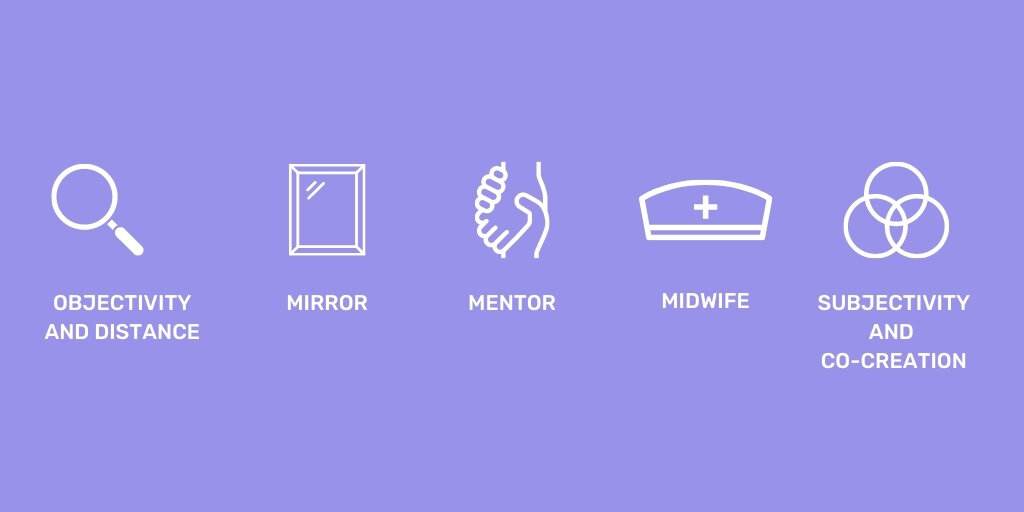The mirror, the mentor and the midwife: What makes a good Learning Partner?
Service Improvement Specialist | @keira_lowther
In our last blog, we examined some of the conditions we think are necessary to make a successful Learning Partnership, building on our experience, and that of colleagues at Renaisi, the Paul Hamlyn Foundation, and Esmée Fairbairn Foundation. As we’ve explored and reflected on Learning Partner contracts, we’ve identified three roles that a Learning Partner takes: The mirror, the mentor and the midwife. Each role blends the “learning for” and “learning with” elements that we described previously, and in our experience, Learning Partners need to be confident shifting between the three as learning needs and capacity changes. In this blog, we look at each role in turn.
The mirror role
The first Learning Partner role is what we call ‘the mirror’. The mirror works to understand practice and show the client what the Learning Partner sees, through expert analysis and critical reflection. They often provide a space for practitioners to consider their work, taking them out of their day-to-day busyness to pause and reflect.
Questions the mirror asks are: What is happening here? What are the patterns and trends across workstreams or projects? What does this mean? Where are the opportunities? Often they will provide data analysis or other research to prompt these reflections – so the skills required are interpersonal and facilitative, and research-based and analytical.
The mirror is appropriate when there is lots of activity within a funded programme but little time available for capturing, and making sense of learning. Sometimes in these cases, the lack of capacity for learning is realised late, and the mirror is bought in to address this. This can make creating buy-in to using learning for improvement harder – so the challenge is to develop firm plans for how this will happen.
The mentor role
The second role we call ‘the mentor’. The mentor focuses on building and supporting skills and approaches that make learning and improvement more likely. They might provide support on data collection and analysis, defining research questions, and identifying opportunities for creating the infrastructure for incremental learning.
The questions the mentor asks are often tied to tasks: What do you need to know/do/use to get to the next stage (and how can I help)? What is stopping progress in this workstream, and what can be done about it? They may also draw upon their own experience and expertise to help the commissioner find the answer.
Often this is the right role when an organisation needs someone to support them to create structures to capture and use learning to improve. The mentor can build the organisation’s capacity and confidence to eventually identify, and act on, learning without their support.
The midwife role
The third role is the midwife (hat tip to @AliceHMThornton for coining this term!). This role is a collaboration between the Learning Partner and organisations, rooted in trust and mutual respect for each’s complementary skills and assets. A midwife Learning Partner will often have been chosen for particular, and perhaps quite specific, knowledge and competencies.
The questions the midwife asks are: ‘Have you thought of this? Have you noticed this is happening? How might that work and what else will we need?’ They use both analytical and facilitative skills to co-create learning that drives a project to which both learning partner and organisation are committed.
This is the right role where there is a strong appetite for, and a plan to use, learning from the outset, and some skills and capacity, but an external voice is required to bring specialist knowledge and accelerate change and adaptation.
Which role might benefit you?
These three roles sit on a spectrum of objectivity and subjectivity. While none occupies the place a traditional evaluation would, the mirror sits closest to the left, reflecting back what is observed, and going beyond that only to help organisations make sense of what they see. The midwife sits at the other end, working in partnership to achieve shared goals. This is a role marked by subjectivity – a significant shift for professionals trained in evaluative skills.
Which role is needed in a particular instance can be determined (in part!). by two questions:
Which role will best provide what is needed, and currently missing?
How ready and able are the organisation(s) to use failure as opportunities for improvement?
In a context of high reflective capacity but low ability to capture and analyse data, a mentor role might be most useful, adding value through building these capacities. When there are high reflective and evaluative capacities the Learning Partner will more often play the role of the midwife, adding value through co-creating the actions to be taken on the basis of learning. When the organisation is not yet skilled at acting on failure, the mirror can build comfort with reflecting on progress and lessons learned while the ‘business case’ for improvement is built. As discussed in our previous blogs, the mirror can also be appropriate for complex consortium projects, or where there may be some mistrust about what the learning will be used for.
At Dartington we undertake and enjoy learning partnerships of all types – we believe all three roles play an important part in helping those working with children and young people to have a greater impact. The rise of the Learning Partner shows that more organisations are on a journey to generate and use their own evidence to improve their work. If this sounds like you, and you’d like to think through how a Learning Partner might benefit your work or your organisation, get in touch!

